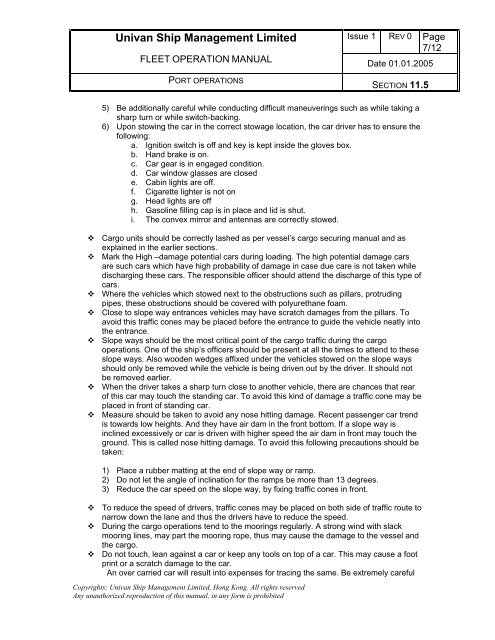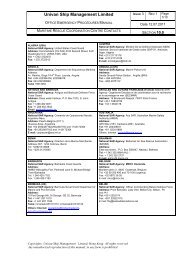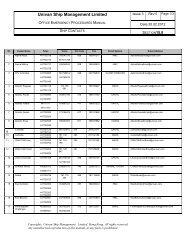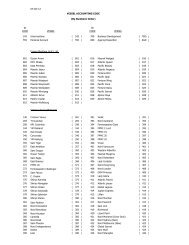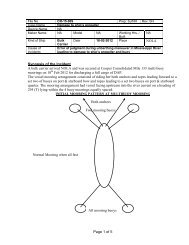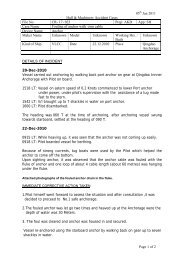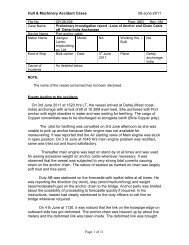Section: 11 CARGO OPERATIONS - Univan
Section: 11 CARGO OPERATIONS - Univan
Section: 11 CARGO OPERATIONS - Univan
You also want an ePaper? Increase the reach of your titles
YUMPU automatically turns print PDFs into web optimized ePapers that Google loves.
<strong>Univan</strong> Ship Management Limited Issue 1 REV 0 Page<br />
7/12<br />
FLEET OPERATION MANUAL Date 01.01.2005<br />
PORT <strong>OPERATIONS</strong><br />
Copyrights: <strong>Univan</strong> Ship Management Limited, Hong Kong. All rights reserved<br />
Any unauthorized reproduction of this manual, in any form is prohibited<br />
SECTION <strong>11</strong>.5<br />
5) Be additionally careful while conducting difficult maneuverings such as while taking a<br />
sharp turn or while switch-backing.<br />
6) Upon stowing the car in the correct stowage location, the car driver has to ensure the<br />
following:<br />
a. Ignition switch is off and key is kept inside the gloves box.<br />
b. Hand brake is on.<br />
c. Car gear is in engaged condition.<br />
d. Car window glasses are closed<br />
e. Cabin lights are off.<br />
f. Cigarette lighter is not on<br />
g. Head lights are off<br />
h. Gasoline filling cap is in place and lid is shut.<br />
i. The convex mirror and antennas are correctly stowed.<br />
Cargo units should be correctly lashed as per vessel’s cargo securing manual and as<br />
explained in the earlier sections.<br />
Mark the High –damage potential cars during loading. The high potential damage cars<br />
are such cars which have high probability of damage in case due care is not taken while<br />
discharging these cars. The responsible officer should attend the discharge of this type of<br />
cars.<br />
Where the vehicles which stowed next to the obstructions such as pillars, protruding<br />
pipes, these obstructions should be covered with polyurethane foam.<br />
Close to slope way entrances vehicles may have scratch damages from the pillars. To<br />
avoid this traffic cones may be placed before the entrance to guide the vehicle neatly into<br />
the entrance.<br />
Slope ways should be the most critical point of the cargo traffic during the cargo<br />
operations. One of the ship’s officers should be present at all the times to attend to these<br />
slope ways. Also wooden wedges affixed under the vehicles stowed on the slope ways<br />
should only be removed while the vehicle is being driven out by the driver. It should not<br />
be removed earlier.<br />
When the driver takes a sharp turn close to another vehicle, there are chances that rear<br />
of this car may touch the standing car. To avoid this kind of damage a traffic cone may be<br />
placed in front of standing car.<br />
Measure should be taken to avoid any nose hitting damage. Recent passenger car trend<br />
is towards low heights. And they have air dam in the front bottom. If a slope way is<br />
inclined excessively or car is driven with higher speed the air dam in front may touch the<br />
ground. This is called nose hitting damage. To avoid this following precautions should be<br />
taken:<br />
1) Place a rubber matting at the end of slope way or ramp.<br />
2) Do not let the angle of inclination for the ramps be more than 13 degrees.<br />
3) Reduce the car speed on the slope way, by fixing traffic cones in front.<br />
To reduce the speed of drivers, traffic cones may be placed on both side of traffic route to<br />
narrow down the lane and thus the drivers have to reduce the speed.<br />
During the cargo operations tend to the moorings regularly. A strong wind with slack<br />
mooring lines, may part the mooring rope, thus may cause the damage to the vessel and<br />
the cargo.<br />
Do not touch, lean against a car or keep any tools on top of a car. This may cause a foot<br />
print or a scratch damage to the car.<br />
An over carried car will result into expenses for tracing the same. Be extremely careful


